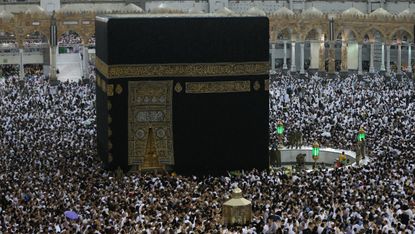Inside the Kaaba: the centre of Islam’s most sacred place of worship
Muslims are starting the yearly pilgrimage to Mecca and the historic Grand Mosque

Millions of Muslim pilgrims are preparing to travel to the holy city of Mecca as the season of Hajj approaches.
Once a year, Muslims from around the world come together in Saudi Arabia to follow the route that the Prophet Mohammad once walked, a journey each worshipper is expected to make at least once in their life if they are able.
The pilgrimage, or Hajj, is one of the five pillars of Islam and is seen as a chance to start anew. During the Hajj, which this year begins on 9 August, everyone wears identical white clothing to perform the same worship.
Subscribe to The Week
Escape your echo chamber. Get the facts behind the news, plus analysis from multiple perspectives.

Sign up for The Week's Free Newsletters
From our morning news briefing to a weekly Good News Newsletter, get the best of The Week delivered directly to your inbox.
From our morning news briefing to a weekly Good News Newsletter, get the best of The Week delivered directly to your inbox.
Last year, more than two million Muslims made the journey, according to Haaretz.
The idea of the annual visit started in AD628, when Muslims believe God told Mohammad to restore the Kaaba.
What is the Kaaba?
The Kaaba, which means “cube” in Arabic, is a large black stone structure in the middle of the Grand Mosque, which is the most sacred place of worship in Islamic tradition.
One part of the Hajj is walking anticlockwise seven times around the famous Muslim shrine while reciting supplications to God.
Muslims do not worship the Kaaba, but observant followers face the structure during their five daily prayers.
The Kaaba is believed to have been built in honour of God by the Prophet Abraham and his son Ismael. Centuries later, however, local pre-Islamic polytheistic groups began worshipping at the structure.
On the eastern corner sits the Black Stone. According to Muslim belief, the stone fell from heaven during the time of Adam and Eve. Pilgrims try to kiss the stone as the Prophet Mohammad is said to have done.
What is inside the Kaaba?
The Kaaba “represents the metaphorical house of God and the oneness of God in Islam”, according to Haaretz, but there is very little inside the building.
Pre-Islamic groups followed many gods and stored idols and statues within the Kaaba. Muslims believe that in the seventh century, God told Mohammad to “restore the Kaaba to the worship of one God only”, says the BBC.
According to the Encyclopedia Britannica: “When Mohammed’s forces conquered Mecca in 630, he ordered the destruction of the pagan idols housed in the shrine and ordered it cleansed of all signs of polytheism. The Kaaba has since been the focal point of Muslim piety.”
Today, only those with special privileges are able to enter the Kaaba.
Create an account with the same email registered to your subscription to unlock access.
Sign up for Today's Best Articles in your inbox
A free daily email with the biggest news stories of the day – and the best features from TheWeek.com
-
 5 high-caliber cartoons about Kristi Noem shooting her puppy
5 high-caliber cartoons about Kristi Noem shooting her puppyCartoons Artists take on the rainbow bridge, a farm upstate, and more
By The Week US Published
-
 The Week Unwrapped: Why is the world running low on blood?
The Week Unwrapped: Why is the world running low on blood?Podcast Scientists believe universal donor blood is within reach – plus, the row over an immersive D-Day simulation, and an Ozempic faux pas
By The Week Staff Published
-
 Rishi Sunak's asylum spat with Ireland explained
Rishi Sunak's asylum spat with Ireland explainedIn Depth Irish government plans to override court ruling that the UK is unsafe for asylum seekers
By The Week UK Published